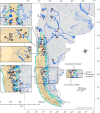Multiple drainage reversal episodes and glacial refugia in a Patagonian fish revealed by sequenced microsatellites
- PMID: 32486985
- PMCID: PMC7341911
- DOI: 10.1098/rspb.2020.0468
Multiple drainage reversal episodes and glacial refugia in a Patagonian fish revealed by sequenced microsatellites
Abstract
The rise of the southern Andes and the Quaternary glacial cycles influenced the landscape of Patagonia, affecting the phylogeographic and biogeographic patterns of its flora and fauna. Here, we examine the phylogeography of the freshwater fish, Percichthys trucha, using 53 sequenced microsatellite DNA markers. Fish (n= 835) were collected from 16 river systems (46 locations) spanning the species range on both sides of the Andes. Eleven watersheds drain to the Pacific, five of which are trans-Andean (headwaters east of Andes). The remaining five drainages empty into the Atlantic. Three analytical approaches (neighbour-joining tree, hierarchical AMOVAs, Structure) revealed evidence of historic drainage reversals: fish from four of the five trans-Andean systems (Puelo, Futalaufquen/Yelcho, Baker, Pascua) exhibited greater genetic similarity with Atlantic draining systems than with Pacific systems with headwaters west of Andes. Present-day drainage (Pacific versus Atlantic) explained only 5% of total genetic variance, while ancestral drainage explained nearly 27% of total variance. Thus, the phylogeographic structure of P. trucha is consistent with episodes of drainage reversal in multiple systems and suggests a major role for deglaciation in the genetic and indeed the geographical distribution of P. trucha in Patagonia. The study emphasizes the significant role of historical processes in the current pattern of genetic diversity and differentiation in a fish from a southern temperate region.
Keywords: Percichthys trucha; drainage reversals; glacial cycles; glacial refugia; phylogeography; sequenced microsatellites.
Conflict of interest statement
Authors declare no competing interests.
Figures



Similar articles
-
Phylogeography of the Percichthyidae (Pisces) in Patagonia: roles of orogeny, glaciation, and volcanism.Mol Ecol. 2006 Sep;15(10):2949-68. doi: 10.1111/j.1365-294X.2006.03010.x. Mol Ecol. 2006. PMID: 16911213
-
Across the southern Andes on fin: glacial refugia, drainage reversals and a secondary contact zone revealed by the phylogeographical signal of Galaxias platei in Patagonia.Mol Ecol. 2008 Dec;17(23):5049-61. doi: 10.1111/j.1365-294X.2008.03987.x. Epub 2008 Nov 12. Mol Ecol. 2008. PMID: 19017262
-
Beringian sub-refugia revealed in blackfish (Dallia): implications for understanding the effects of Pleistocene glaciations on Beringian taxa and other Arctic aquatic fauna.BMC Evol Biol. 2015 Jul 19;15:144. doi: 10.1186/s12862-015-0413-2. BMC Evol Biol. 2015. PMID: 26187279 Free PMC article.
-
Evaluating signatures of glacial refugia for North Atlantic benthic marine taxa.Ecology. 2008 Nov;89(11 Suppl):S108-22. doi: 10.1890/08-0257.1. Ecology. 2008. PMID: 19097488 Review.
-
Extreme Glacial Legacies: A Synthesis of the Antarctic Springtail Phylogeographic Record.Insects. 2011 Apr 6;2(2):62-82. doi: 10.3390/insects2020062. Insects. 2011. PMID: 26467614 Free PMC article. Review.
Cited by
-
Genetic Diversity and Demographic History of the Shaggy Soft-Haired Mouse Abrothrix hirta (Cricetidae; Abrotrichini).Front Genet. 2021 Mar 24;12:642504. doi: 10.3389/fgene.2021.642504. eCollection 2021. Front Genet. 2021. PMID: 33841502 Free PMC article.
-
Contrasting evolutionary responses in two co-distributed species of Galaxias (Pisces, Galaxiidae) in a river from the glaciated range in Southern Chile.R Soc Open Sci. 2020 Jul 8;7(7):200632. doi: 10.1098/rsos.200632. eCollection 2020 Jul. R Soc Open Sci. 2020. PMID: 32874654 Free PMC article.
-
Genomic data support management of anadromous Arctic Char fisheries in Nunavik by highlighting neutral and putatively adaptive genetic variation.Evol Appl. 2021 May 27;14(7):1880-1897. doi: 10.1111/eva.13248. eCollection 2021 Jul. Evol Appl. 2021. PMID: 34295370 Free PMC article.
References
-
- Fraser CI, Nikula R, Ruzzante DE, Waters JM. 2012. Poleward bound: biological impacts of Southern Hemisphere glaciations. Trends Ecol. Evol. 27, 462–471. - PubMed
-
- Beheregaray LB. 2008. Twenty years of phylogeography: the state of the field and the challenges for the Southern Hemisphere. Mol. Ecol. 17, 3754–3774. - PubMed
Publication types
MeSH terms
Substances
Associated data
LinkOut - more resources
Full Text Sources

